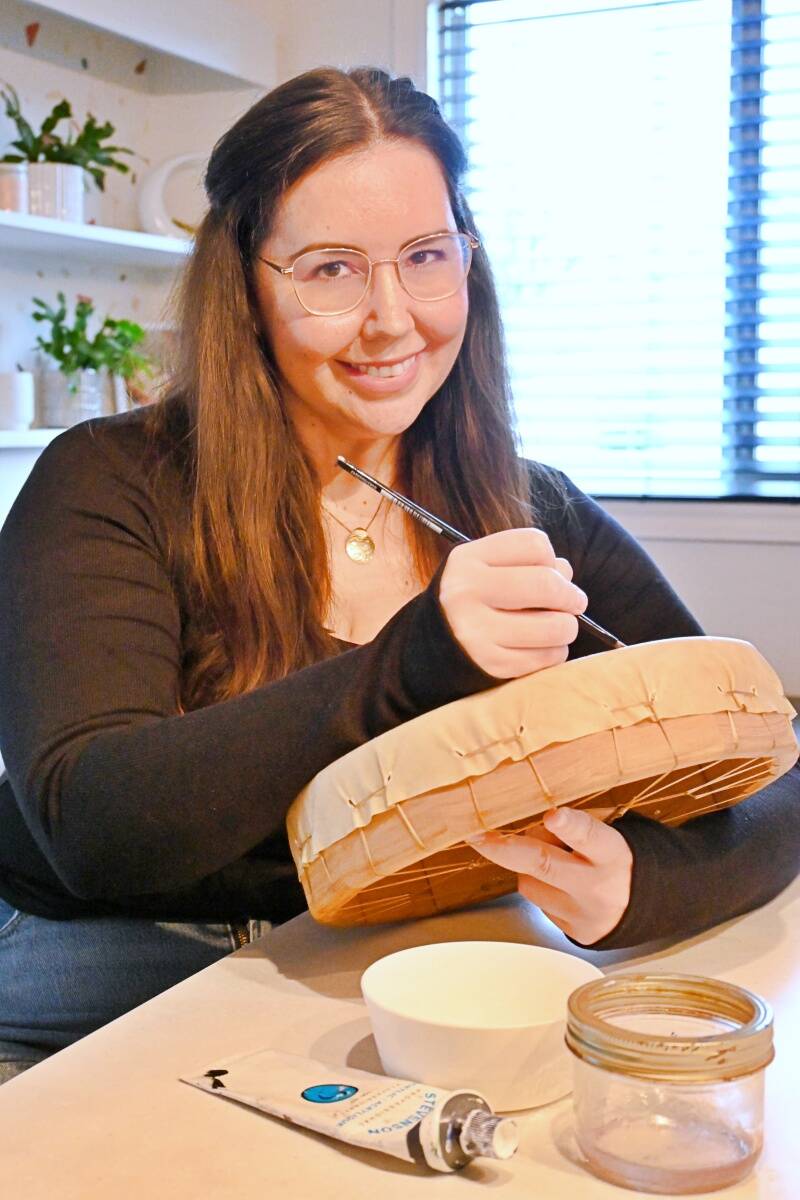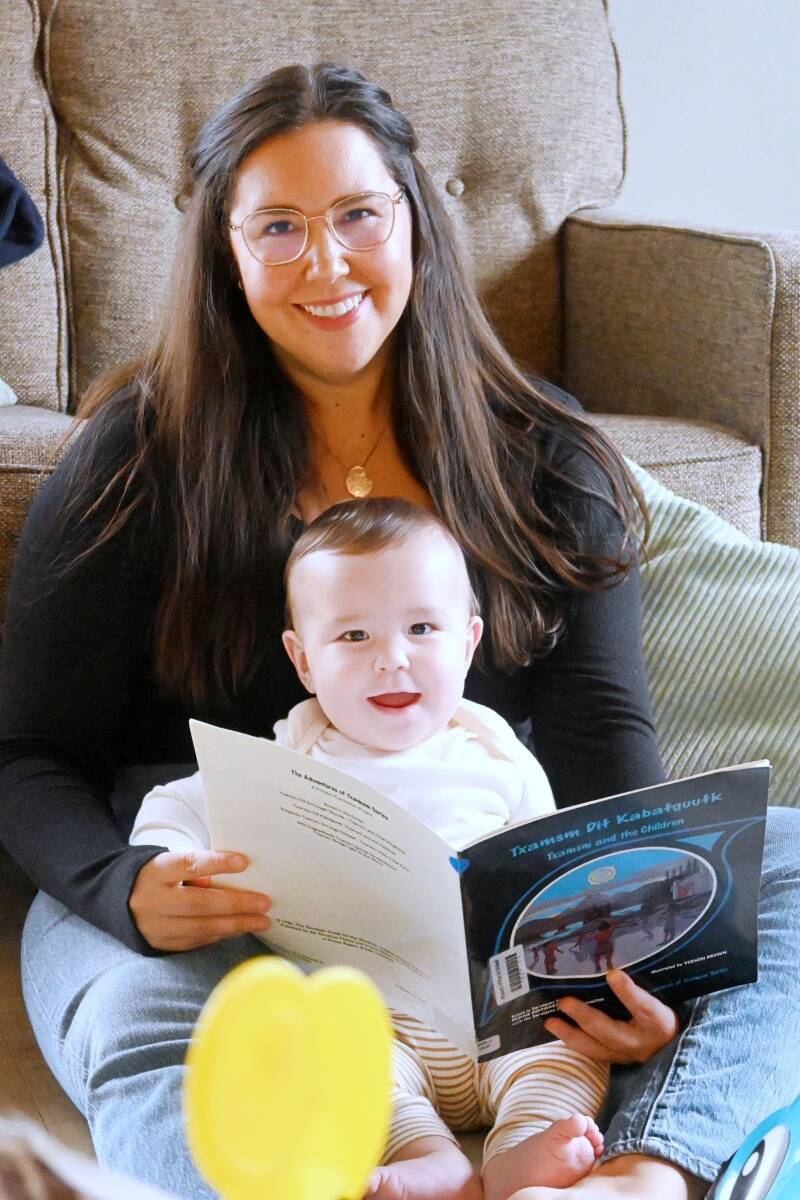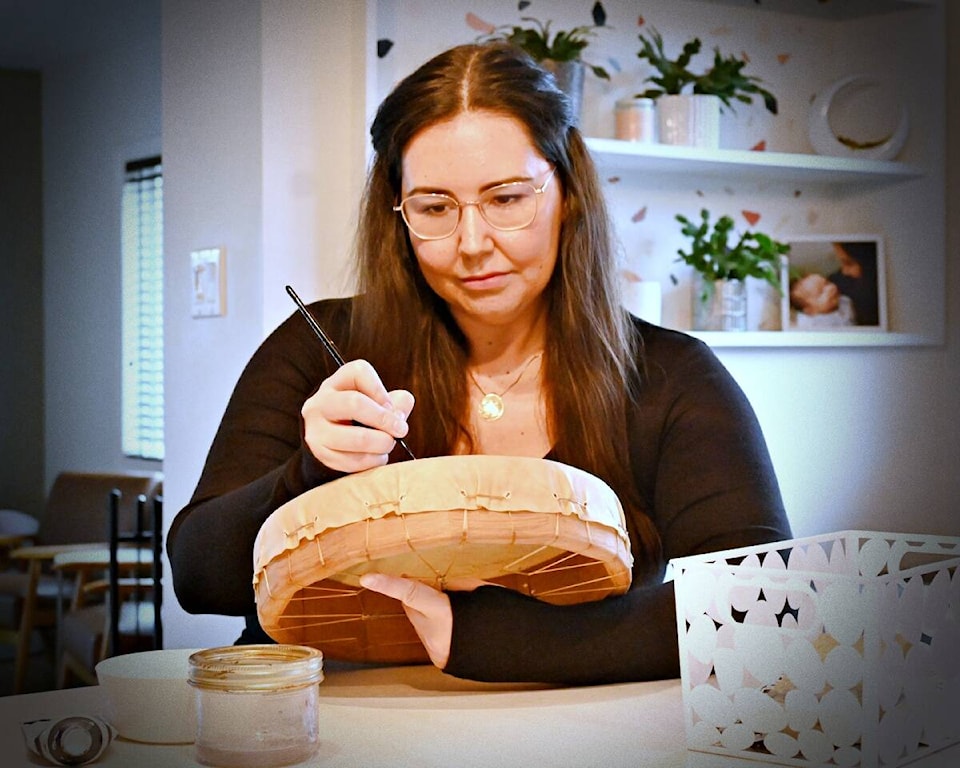Kelli Clifton is quickly becoming a renowned Ts’msyen artist who weaves the Sm’algya̱x language into her work.
From a young age, Kelli was drawn to art. Her parents told her she saw the world through a different lens than those around her. On walks with her family she would notice things, like a bird, that no one else could see.
Food gathering and, in particular, fishing have always been an inspiration for her work. Her dad, who is from Hartley Bay (Txałgiiw) takes her out on the Skeena River every year to fish.
When she was 17 years old, she pursued her passion by enrolling in a bachelor of fine arts at the University of Victoria.
During her undergraduate degree, though, she was not as into the local North Coast style of art as she is known for now. After finishing her degree, she applied to the Freda Diesing School of Northwest Coast Art, hoping to build on and improve her design skills.
“My two years there literally changed my life as an artist. I would not be producing the works that I am today if I hadn’t attended that school,” Kelli said.
She credits her instructors at Freda Diesing School for giving her the knowledge and guidance which have made her the artist she is today.
The second significant moment that changed the direction of her art was embarking down a path to learn Sm’algya̱x, the language traditionally spoken by the Ts’msyen people.
Kelli’s father attended Indian Day School, like many First Nations people at that time. Residential Schools and Indian Day Schools taught Indigenous students to be ashamed of their native languages and many grew up as “silent speakers”. These are people who could fluently speak the language at one point in their life and possibly still understand it but could no longer speak it. For this reason, Kelli did not grow up hearing Sm’algya̱x, she said.
In 2015, after moving back to the North Coast, a friend invited her to evening community language classes. A year after she started learning Sm’algya̱x she was invited to teach it at the elementary school and then later at the secondary school.
As a teacher, she felt like she has to be a step ahead of her students so she had to learn more quickly.
“When I started teaching our language, I just realized how necessary it is for our youth to see a younger person dedicating themselves to language learning and how important it is for language revitalization. I want these students to realize that learning their culture, learning their language, producing their traditional artworks is cool.”
Some of her students speak Sm’algya̱x to her when they run into her on the street downtown. Others have told her they want to become Sm’algya̱x teachers themselves.
During the COVID-19 pandemic, in order to help connect with students, she gave them her cellphone number and got calls from one of her students with his grandma, saying his grandma could not remember how to say a certain word and asking if she could help.
To Kelli, moments like these show her that her students are proud of where they come from and learning the Sm’algya̱x language is helping them make connections with their families.
Learning about the language also gives Kelli and her students insight into how their ancestors thought, she explained.
In Sm’algya̱x the word for mushroom is g̱aayda̱ baa’la̱x. If you break it down, g̱aayda̱ is the word for hat and baa’la̱x means ghost or reincarnation.
When Kelli is teaching a food unit, she always has a fun conversation discussing this word, she said.
“Did our ancestors see these things and say, Hey, these look like ghost hats,” she says to her students.
“It’s just so cool how the language comes together and helps you to imagine what our ancestors were thinking at the time,” Kelli said.
The Ts’msyen Sm’algya̱x Language Authority created an online dictionary and a plethora of resources to support language learners in Prince Rupert.
“Our Sm’algya̱x Language Authority has done incredible things for our language and our community,” Kelli said.
“Right now is a really crucial time for language revitalization. Unfortunately, many of our fluent speakers will not be around in the next 20 to 30 years so we are in desperate need of gaining speakers.”
She would like to see a language immersion program and would also like to see programming to encourage silent speakers to start speaking again.
“If I could choose between winning the lottery or speaking my native language fluently, I would choose to speak my language,” she said.
While learning the Sm’algya̱x language, Kelli began incorporating it into her art.
During an artist residency at the Santa Fe Art Institute, she created a body of work around traditional foods and language, which included pairs of canvases depicting an image on one canvas, a crab, for example, and the corresponding Sm’algya̱x word on a second canvas.
A lot of her recent work either incorporates Sm’algya̱x words into the piece or, if they are not visibly displayed in the work, she will often provide the title in the Ts’msyen language.
“I’ve always been interested in incorporating text with art,” she said.
Kelli’s piece called G̱aksdanaa (behold!) was purchased by the Canada Council Art Bank, the organization announced Jan. 18. It features the word G̱aksdanaa in shimmering paint over a formline design.
“Gaksdanaa is a word in Sm’algya̱x that often appears in our adaawx (true tellings) when something dramatic is about to happen. It essentially means ‘behold!’ and has become a fan-favourite word amongst language learners,” Kelli said.
“I wanted to create a painting that captures the mysterious nature of our adaawx, the fun aspects of language learning and the pure joy that Sm’algya̱x learners feel whenever we see or hear this word.”
Kelli sees her art as another avenue to draw people into the language and potentially inspire them to learn it.
“I think that art connects with people in a different way,” Kelli said.
“It’s one thing to say to somebody, ‘Hey, you should come to community classes and try learning.’ But they might see one of my masks and read the word in Sm’algya̱x and read what it means and feel super connected.”
As a language learner, teacher and artist Kelli has a lot on her plate. If she gave up teaching or learning Sm’algya̱x, she would have more time to do art, but she said she could never do that.
“I feel that if I were to remove one, then the works that I create as an artist aren’t going to be as powerful. I don’t get to produce work as often as an artist who can dedicate their entire career to just art, but I do feel that when I produce my work, a lot of thought has gone into them.”
“And I really feel like it’s a piece of my soul because it usually comes from months and sometimes even years of being inspired by one idea, sitting around listening to our fluent speakers, listening to my students share stories. It’s all connected for me.”
READ MORE: Prince Rupert Ts’msyen artist’s work bought by Canada Council Art Bank
Kaitlyn Bailey | Local Journalism Initiative Reporter
Send Kaitlyn email
Send The Observer email
Like the The Northern View on Facebook
Follow us on Twitter


